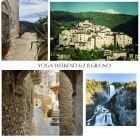The ideal city of the future?
Just beyond the extreme western boundary of Rome, a new so-called city of the future is taking shape, heralded by its inventors, with a dash of hyperbole, as a modern version of the famed ideal cities of the Renaissance.
Described as the biggest private housing project ever undertaken in Italy, it will be without precedent a city without cars or scooters. Some 2,500 people have been living there since 2003; within the next three months, it is claimed the numbers will have swollen to 5,000; and with the completion of the mini-city in 2006, to some 10,000 with office space for as many again.
The place can be glimpsed from the Rome-Fiumicino train after Ponte Galeria station, close to the airport and on the left-hand side, about 25 soccer pitches long, between the rail tracks and Via Portuense.
The idea is the brainchild of 58-year-old Leonardo Caltagirone, born in Argentina, one of the best-known building tycoons and entrepreneurs in Rome. His familys company has just announced a doubling of profits over the past year. His son, Leonardo Francesco, explained how the idea came to him. My father was walking down Via del Corso one evening in the 1990s and was suddenly struck by the difficulty a young couple was having dodging the traffic, obviously in a hurry to get to the cinema in time. He thought to himself: What about a city totally without obstacles between its people and its amenities?
So Caltagirone commissioned the well-known Spanish architect, 66-year-old Ricardo Bofill, to realise the idea. The Penguin dictionary of architecture calls Bofill rhetorical, even megalomaniac but he is also credited with bringing grandeur and monumentality to public spaces. Leonardo Francesco added: Bofill is very much into intermingling what he calls flows of people and ideas and the result will be a place totally pedestrianised, with traffic and parking kept completely underground. Each flat will have its own garage beneath it, accessible by lift. The citys kernel feet-only precinct is to be a succession of linked squares animated by 120 shops and as many as 40 restaurants.
Leonardo Francesco, 31, whose uncle, Francesco G. Caltagirone, owns the Rome newspaper Il Messaggero, said the Rome city council had absolutely nothing to do with the venture, already 40 per cent completed, since it was sited beyond its perimeter within the confines of the township of Fiumicino.
But there is more to Parco Leonardo, as it has been baptised, than an architects vision. You can no longer live decently in Rome what with the smog and everything, said Leonardo Francesco. Our park reflects a current tendency among Romans to move out of the centre. Our flat-owners will often be people who no longer want to commute in and out and have decided to shift out altogether, to a self-contained place where they can both work and live. When its finished, everybody will be within two minutes of everything, he beamed.
The flats are currently going for e3.500 per square metre. Salespeople and clients were in huddles over tables in a white pre-fab building on the site marked vendite and it seemed the apartments were being snatched up at a rate of knots. One agent-seller was Fabiola Poggelli. At the outset, because of a special offer, our buyers tended to be newly-weds acquiring their first home. Now though theyre older, from the middle bourgeoisie, many from the professional classes with money.
Already in business, amid all the mess of a building site, is a massive luxury cinema complex, the biggest in Italy, with 25 screens showing the latest releases.
Poggelli was negotiating sales in the first of the citys four planned residential quarters known as Athena, a massive theatre-like horseshoe of tiered rows of flats set around an elliptical square, its pivot a huge monumental fountain.
Far away to one side is one of the other residential zones, called Polis after the Greek city-states, and on the other side a vast area of greenery with sports fields, 20 theme parks and an artificial lake. To complete the picture, add a mammoth shopping centre, schools for the kids, two four-star hotels, a new railway station on the airport line and a road-link to the Rome-Fiumicino motorway.
But even so there is little real comparison between Parco Leonardo and the real ideal cities tiny Pienza near Siena, sometimes called the pearl of the Renaissance; the breathtaking utopia of Sabbionetta south of Mantova, conceived by Prince Vespasiano Gonzaga in the 16th century; and the star-shaped fortress city of Palmanova, not far from Udine, a lavish display of impeccable geometry. By contrast, the residents of the park will be living in what may strike the more sceptical as chicken-hatcheries.
What will also doubtless detract from ideal living will be the jungle roaring of beasts leaping into the sky from Fiumicino airport and the new environment emerging on the final stretch of Via Portuense. Once spooky with the shades of ancient Rome on a moonlit night, today cranes are putting into position a site for the new Fiera di Roma exhibition centre, as well as a sprawling industrial estate and still more pile-drivers.
What else could the future hold?

















